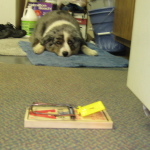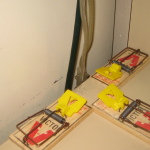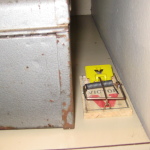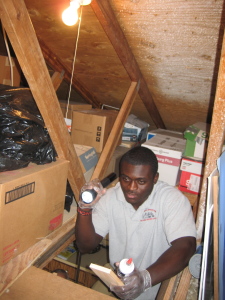 Rodent traps have been part of a massive ongoing effort to getting rid of rats and mice since time began. Rodent control devices are big business but it seems like there are just as many if not more of home made traps. Contraptions and designs from the gruesome and border line cruel to high-tech and perhaps completely painless. Man has been driven to these innovations because rats and mice do millions if not a billion or more in damages to food, houses, personal belongings and related health care costs every year. In some countries the rodent populations are completely out of control. Rats and mice are simply an everyday, every hour of everyday occurrence. I truly wish this wasn’t the case.
Rodent traps have been part of a massive ongoing effort to getting rid of rats and mice since time began. Rodent control devices are big business but it seems like there are just as many if not more of home made traps. Contraptions and designs from the gruesome and border line cruel to high-tech and perhaps completely painless. Man has been driven to these innovations because rats and mice do millions if not a billion or more in damages to food, houses, personal belongings and related health care costs every year. In some countries the rodent populations are completely out of control. Rats and mice are simply an everyday, every hour of everyday occurrence. I truly wish this wasn’t the case.
But modern traps and devices don’t have to be the driving force of rodent control- in fact- the old cliche comes to mind of “why reinvent the wheel?”
Did you know that the standard mouse snap trap wire slams closed in 38,000’s of a second? That every year over 400 patents are applied just for mouse trap inventions? Up to this time, there are total of 4400 patented mouse traps but there are only about 20 of them make money. The first trap was invented back in 1897 by James Henry Atkinson, a British inventor and his prototype of the wooden snap trap with springs and wires has not changed much at all since then. In the 1980’s glue boards were invented and widespread use was like a wild fire until people realized that the mouse died a slow and agonizing death usually squealing and dying from exhaustion.
There are many advantages of using snap traps. They are humane, they can be reused and are versatile. It can be anchored with a nail or string which can be helpful in keeping a partially caught rodent from escaping. It can be set in a all sorts of locations and even be effective in areas where baits are not an acceptable technique. Snap traps can also be baited with a number of different irresistible food baits and or lures., cotton, tin foil, dental floss, seeds, and yes cheese or even peanut butter etc.
are versatile. It can be anchored with a nail or string which can be helpful in keeping a partially caught rodent from escaping. It can be set in a all sorts of locations and even be effective in areas where baits are not an acceptable technique. Snap traps can also be baited with a number of different irresistible food baits and or lures., cotton, tin foil, dental floss, seeds, and yes cheese or even peanut butter etc.
ou should know some safety tips. You should put in mind that snap traps closes very quickly and in a blink of an eye you could be reminded of this while setting the trap. Or even worse you don’t want your kid’s fingers or animal’s toes to be caught on it so let’s run through the basics. Bait your trap before you set it.
To set a mouse or rat trap safely follow these instructions;
A new wooden snap trap will have its trigger arm secured with a half moon staple. With hands gloved, remove this staple so that the arm can move freely. Also- It’s at this time you should decide what you’re using for bait and apply that at this time BEFORE you set the trap. Note; mice are curious and will be enticed with many different baits like peanut butter or nesting materials such as cotton or string.
Rats however are a bit more cautious- if possible, try and determine what foods they have been eating already and bait your trap with the same. In some cases it’s even desirable to bait the trap without setting it. This allows a certain level of comfort to set in or for trap shy rats to more readily explore this possible food source.
Setting The Trap
Put the trap on the floor with tongue end pointing away from you. Place the end of your shoe just over the back corner of wooden trap for support. With your fingers grab the trap wire and pull it towards your toe, and tuck it up underneath there and hold it down with your foot. Take the trigger arm, pull it over and put it on the slot, found at the back of the tongue. The tongue may need to be raised slightly as trigger arm engages the slot. Slowly lift your toe allowing the pressure of the trigger arm to lock itself in the tongues back slot. Once you’re fairly confident the trap take your fingers away from the tongue and then your foot off and away from the trap and your all set. If it goes off, you are all clear as long as you follow those steps.
 To move the trap to your desired location always grab your trap from the back two corners, never the front where the trap wire slams down. Now if the desired placement is not one where you can easily place by hand, place the trap as close as possible and move it the rest of the way with a utensil or tool and always from the back end.
To move the trap to your desired location always grab your trap from the back two corners, never the front where the trap wire slams down. Now if the desired placement is not one where you can easily place by hand, place the trap as close as possible and move it the rest of the way with a utensil or tool and always from the back end.
Do not place your trap in an area where your kids or pet could come in contact. This may seem to limit you but by realizing full scope of a rodents movement you will find a safe and effective setting for placement. Mice usually go in any direction from their nest up to 10 or 15 feet while rats can venture as far as 35 to 50 feet, also in any direction. Mice and rats move horizontally and vertically with ease so think multi directional. Ceilings, walls, basements or crawlspaces could all easily be a nesting site. The important thing is to find feeding or traveling sites where your traps can be effective . There is almost always a right spot to safely place your trap.
Mice and rats run along the walls. They have very poor eyesight so the walls give them security and they use their whiskers to feel their way just like a blind man using his cane. Traps placed away from walls seldom work. The tongue end of the trap must be placed close to the wall for better chances to catch rats and mice. Rodents are excellent climbers, use this to your advantage and find areas that force them to your trap such as wires or runways behind refrigerators or in between stored items etc. If you can’t find a gauntlet of this sort you can easily make one. By using items the rodent is already familiar with you can place the items in such a way that the rodent has no other choice but to come across your trap.
can place the items in such a way that the rodent has no other choice but to come across your trap.
The rat or mouse has no problem with getting creative in how it finds its food in your home and let alone cares what it contaminates along the way. We however can’t be so care free in our trap placement. We must take care to protect our families and pets while at the same time ensuring positive effective trapping techniques that will quickly and efficiently put us on top of our rodent problems. Let us do this with all safety. Why not get service from a pro?




